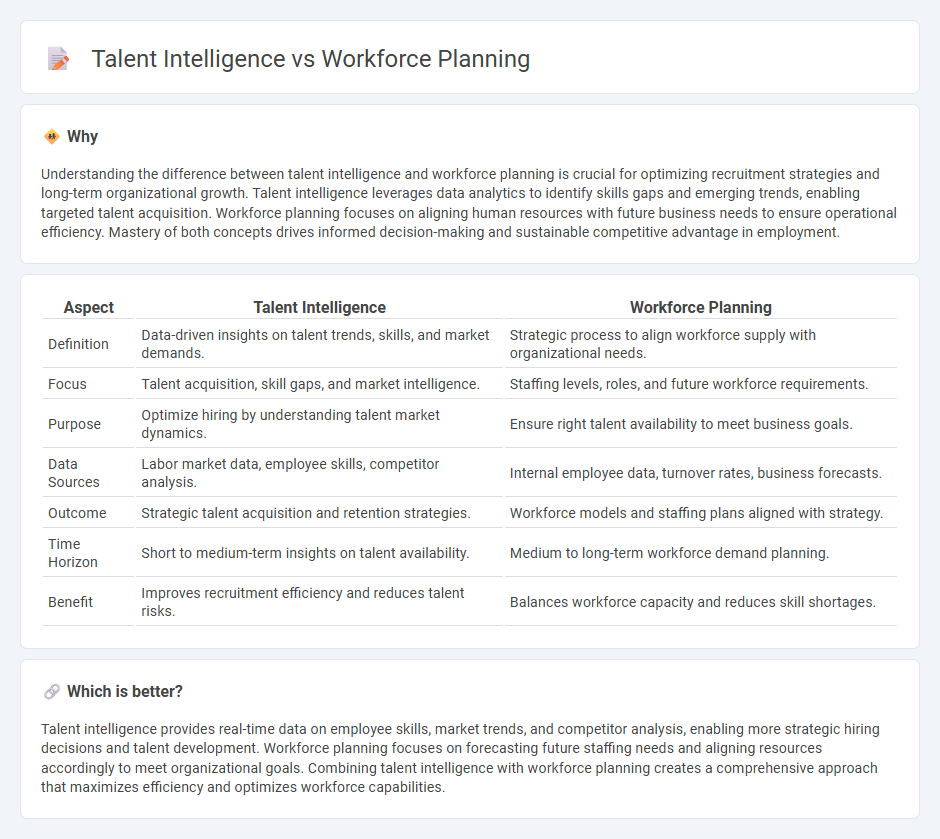
Talent intelligence leverages advanced data analytics and AI to identify, assess, and predict the skills and capabilities needed to drive business success. Workforce planning focuses on aligning the organization's human resource requirements with its strategic goals by analyzing current workforce data and forecasting future needs. Explore how integrating talent intelligence with workforce planning can optimize hiring strategies and enhance organizational agility.
Why it is important
Understanding the difference between talent intelligence and workforce planning is crucial for optimizing recruitment strategies and long-term organizational growth. Talent intelligence leverages data analytics to identify skills gaps and emerging trends, enabling targeted talent acquisition. Workforce planning focuses on aligning human resources with future business needs to ensure operational efficiency. Mastery of both concepts drives informed decision-making and sustainable competitive advantage in employment.
Comparison Table
| Aspect | Talent Intelligence | Workforce Planning |
|---|---|---|
| Definition | Data-driven insights on talent trends, skills, and market demands. | Strategic process to align workforce supply with organizational needs. |
| Focus | Talent acquisition, skill gaps, and market intelligence. | Staffing levels, roles, and future workforce requirements. |
| Purpose | Optimize hiring by understanding talent market dynamics. | Ensure right talent availability to meet business goals. |
| Data Sources | Labor market data, employee skills, competitor analysis. | Internal employee data, turnover rates, business forecasts. |
| Outcome | Strategic talent acquisition and retention strategies. | Workforce models and staffing plans aligned with strategy. |
| Time Horizon | Short to medium-term insights on talent availability. | Medium to long-term workforce demand planning. |
| Benefit | Improves recruitment efficiency and reduces talent risks. | Balances workforce capacity and reduces skill shortages. |
Which is better?
Talent intelligence provides real-time data on employee skills, market trends, and competitor analysis, enabling more strategic hiring decisions and talent development. Workforce planning focuses on forecasting future staffing needs and aligning resources accordingly to meet organizational goals. Combining talent intelligence with workforce planning creates a comprehensive approach that maximizes efficiency and optimizes workforce capabilities.
Connection
Talent intelligence enhances workforce planning by providing data-driven insights into employee skills, labor market trends, and potential talent gaps. Integrating talent intelligence tools enables organizations to forecast hiring needs accurately and align workforce strategies with business goals. This connection ensures optimized talent acquisition, retention, and development for sustained organizational performance.
Key Terms
**Workforce Planning:**
Workforce planning involves analyzing current employee skills, forecasting future workforce needs, and aligning talent acquisition with organizational goals to ensure optimal staffing levels. It emphasizes data-driven strategies to predict labor market trends and manage talent supply efficiently. Discover how strategic workforce planning can enhance your organization's agility and competitive advantage.
Headcount Forecasting
Workforce planning involves analyzing current headcount and projecting future staffing needs based on business goals and market trends, ensuring optimal resource allocation. Talent intelligence leverages data on skills availability, labor market dynamics, and competitor analysis to refine headcount forecasting accuracy and align recruitment strategies. Explore deeper insights into how integrating workforce planning with talent intelligence enhances predictive accuracy and strategic hiring decisions.
Succession Planning
Workforce planning ensures organizations forecast future staffing needs and align roles with business goals, while talent intelligence leverages data analytics to identify high-potential employees for critical roles. Succession planning benefits from integrating talent intelligence by accurately mapping skills, performance, and potential to prepare effective leadership pipelines. Explore how combining workforce planning and talent intelligence can enhance your succession strategies.
Source and External Links
What Is Workforce Planning? Strategies and Benefits - Paychex - Workforce planning is the process of analyzing an organization's future staffing needs and developing strategies to meet those requirements by assessing current workforce, forecasting needs, identifying gaps, developing action plans, and monitoring progress.
Workforce Planning: Definition, Process and Principles | Indeed.com - Workforce planning involves analyzing, forecasting, and planning workforce supply and demand, starting with determining strategic direction and conducting supply and demand analyses to ensure business goals are met with the right talent.
Workforce Planning - NIH: Office of Human Resources - Workforce planning is a cyclical process of analyzing, forecasting, assessing gaps, and implementing talent management strategies to ensure an organization has the right people with the right skills in the right places at the right time.
 dowidth.com
dowidth.com